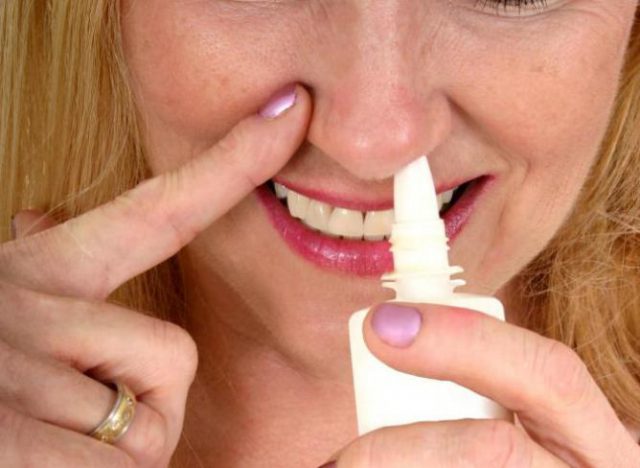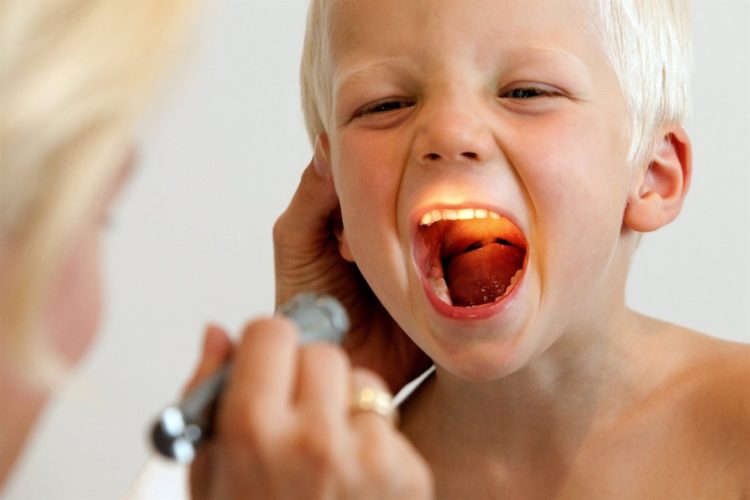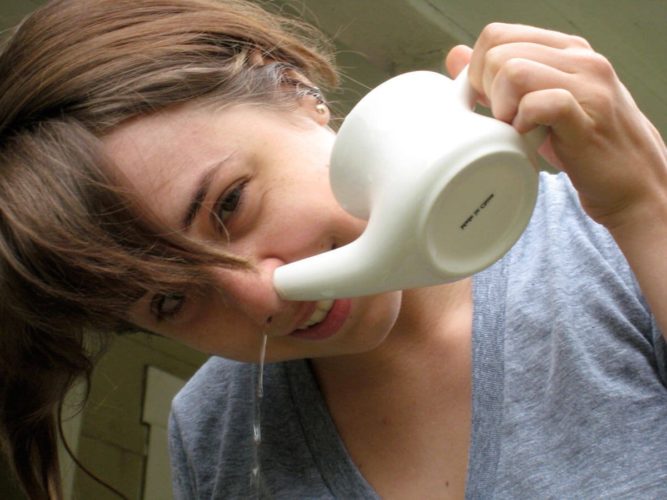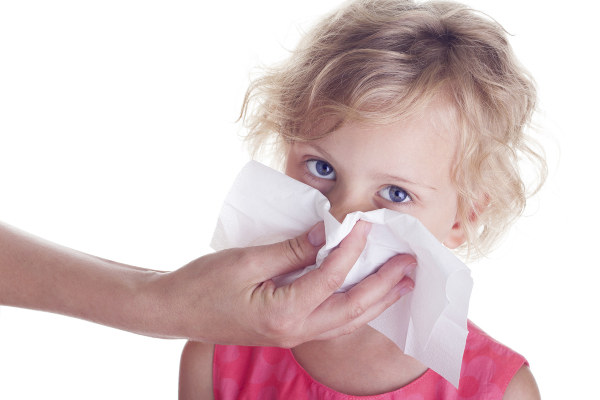Posterior rhinitis or rhinopharyngitis is an inflammatory process that affects the cavity and nasopharynx. Pathology most often has a viral etiology and is manifested by the consequences of respiratory diseases. Less commonly, anatomical changes provoke antigens, hypothermia or heatstroke.
The course of acute nasopharyngitis is accompanied by a dry cough, elevated temperature body, discomfort in the pharynx and paranasal sinuses. There are many therapeutic options for treating snot on back wall in a child and an adult. Effective method for each clinical case, an otolaryngologist makes an individual case.
In response to soft tissue damage caused by viruses and bacteria, the body produces an excessive amount of secretory secretions... The accumulation of mucus in the pharyngeal ring irritates the receptors of the cough reflex, resulting in a cough due to snot along the back wall.
Forced exhalation through the mouth intensify at night... This explains the fact that when a person takes a horizontal position, sputum does not find a way out, it begins to flow down the cavity behind the nose and the palatine arches.
For reference! Mucous discharge passes through the vomiting center, therefore, it can provoke a reflex eruption of stomach contents (vomiting).
Therapy for rhinovirus infection in adults and children begins with relief and bouts of unproductive cough. Convulsive exhalations with secretion of bronchial secretions indicate serious pathological changes, complications of the inflammatory process.
Rhinopharyngitis is manifested by sore throat, nasal congestion, runny nose, fever
Gargling
Antiseptic efficacy in the fight against pathogens has been proven edible salt... For cooking, you need a glass of purified water ( t 36-38 ° С), incomplete a teaspoon of cooking or sea \u200b\u200bsalt, 1 drop of iodine... For the treatment of children, the concentration of a useful reagent decreases up to 10-15 grams per liter of water.
When rinsing, the head is thrown back wellso that the liquid washes the larynx area as much as possible, flows into the nasopharynx. The suspension removes mucus accumulations, removes pathogenic agents from the body, removes pain, accelerates the process of epithelial regeneration.
It will be effective for infectious diseases of the upper respiratory tract. The complex composition of the herbal product is represented by more than 40 components that cause bacteriostatic, immunomodulatory, antiseptic and expectorant effects.
For reference! The oils of geranium, lavender, bergamot and tea tree have healing properties.
The combination of external therapy with internal intake brings positive dynamics, accelerates the healing process. Eucalyptus infusion is prepared as follows: for a glass of boiling water fall asleep a tablespoon dry raw materials, leave for half an hour. Take 20-30 ml. 3-4 times a day.

When rinsing the throat, the head is thrown back well to treat the foci of inflammation in hard-to-reach places
Antiseptic drugs
Synthetic products are presented in a variety of release forms: sprays, tablets, lozenges, rinses. Mostly used in complex therapy.
main destination - inhibition of the synthesis of pathogenic strains, prevention of the development of viral and bacterial forms acute nasopharyngitis. The action of the drugs is aimed at the formation of local immunity, accelerating the epithelialization of soft tissues.
Antibacterial medicines active in the initial stages of the inflammatory processsince act at the intercellular level. They are characterized by local manifestation, practically not absorbed into the bloodstream, do not cause systemic reactions.
Not recommended for children under 3 use aerosols for irrigation of the throat, lozenges, and lozenges and lozenges can be used from the age of five. For small patients, the best option is to treat the larynx with a solution or rinse.
First defense drugs are presented:
- in the form of sprays: "Stopangin", "", "Tantum Verde", "Maxisprey", "";
- lozenges: "Gorpils", "Grammidin", "HexoralTabs", "Strepsils";
- aerosols: "Hexasprey", "";
- lozenges: "Isla-mint", "Askosept", "Septolete", "Astrasept";
- solutions for topical use: "Lugol", "Angilex", "", "Stopangin".
Before the appointment, the doctor identifies the sensitivity of pathogenic strains to the constituents of pharmaceutical products. Treatment course and dosage for each case determined by the doctor on the basis of anamnesis, physiological characteristics the patient.
Average recovery time varies from 5 to 6 days, in chronic forms of inflammation - up to 10 days... With caution, antiseptics are included in the drug regimen for pregnant and lactating women, persons with hypersensitivity to individual components.
Antibiotics for rhinovirus infection
Antibiotic treatment is practiced, when therapy with gentle medications did not bring positive dynamics.
The indications for the appointment of drugs are deviations:
- increased body temperature to a subfebrile level 38 ° С for 5 days or more;
- defeat;
- suspicion of not pneumonia;
- aggravation acute form rear.
The effect of the antibiotic lies in the ability of active components to affect the focus of pathological inflammation, to bind with proteins of the lymph serum.
For reference! To achieve a therapeutic effect, medications should be taken an hour before or after meals.
Widespread in ENT practice received three groups of pharmaceutical products:
- penicillins - "", "Ampitsilin";
- macrolides - "", "Erythromycin", "Spiramycin";
- cephalosporins - "Ceftriaxone", "Cefazolin".
Synthetic drugs are prescribed systemic and local action... For irrigation of the mucous membrane, aerosols are used, for the treatment of granules on the back wall of the pharynx - antibacterial solutions, oral administration of tablets and intramuscular injection is possible.

With effective and timely treatment, you can defeat the disease in 5-7 days
Important! "" Has pronounced sectolytic and bronchodilatory properties. Its reception provides relief of coughing attacks, a decrease in the viscosity of sputum, and facilitates its excretion.
For the complete destruction of pathogens you need to undergo a ten-day course of treatment... Non-systemic antibiotic therapy is fraught with a decrease in the effectiveness of medicinal properties, the development of side effects.
Nasal preparations
The problem, when snot flows down the back wall and a cough is constantly present, is solved by injecting a spray into the paranasal sinuses. In order for the medicinal fluid to enter the nasopharyngeal vault, the nose is instilled in a lying position, with the head thrown back.
Upon completion of the procedure body position does not change for another 5 minutes... Depending on the etiology of the lesion of the nasopharynx, the following types of drops are used:
Vasoconstrictor
The main active substance is phenylephrine ("", in pediatrics "NazolBaby" and "NazolKids"), oxymetazoline ("", "Rinazolin"), xylometazoline ("", "Galazolin") and naphazoline ("").
The action of all pharmaceutical groups is reduced to reducing nasal congestion, relieving edema, and normalizing drainage function. The difference lies in the duration of the therapeutic effect from 4 to 10 hours... The accessory sinuses are irrigated through every 4 hours, in children under 6 years old - from 2 to 3 manipulations per day.
The course of treatment is limited 3-5 days, with serious pathological disorders reaches the milestone in 10 days... Unsystematic use increases the risk of drying out of the mucous membrane, the development of a drug effect;
Moisturizers
The composition of medicines is represented by purified sea water with admixtures of useful trace elements: potassium, calcium, magnesium, phosphorus, sodium chloride. Designed for mechanical cleaning of the nasal cavity, facilitating mucus discharge, preventing the formation of crusts.
It is possible to dose drugs without restrictionsince they are not addictive. They are used as a preventive measure for respiratory diseases... You need to carry out therapeutic or hygiene procedures up to 6 times a day. Widespread in otolaryngology received "", "No-Sol", "Humer", "Marimer", "", "Salin";
Oil
They are characterized by a weak healing effect. Their main purpose - restoring natural breathing through the nose, alleviating the symptoms of rhinitis, moisturizing the nasal epithelium. They exhibit antiseptic and anti-inflammatory activity. Efficacy against gram-positive and gram-negative strains was proven by tea tree oil, sea buckthorn, peppermint and Scots pine.
The presence of the vitamin complex, volatile plant components of peach and almond enhances the regenerative capacity of the epithelium, forms local immunity. If the snot of the back wall is flowing, then "", "Sinusan", "Pinovit", "Vitaon", "Eucasept" will be effective in treatment. They are appointed 1-2 drops in every nostril three times a day, duration from 5 to 10 days.

To confirm the diagnosis, the doctor conducts a visual examination oral cavity, CT scan, sampling of biological material, blood test
Fact! A high therapeutic result was shown by the treatment of the paranasal sinuses essential oils... Wipe the nasal openings with a moistened cotton swab 2-3 times a day. Carefully carry out the procedure for children so as not to injure the mucous membrane.
In addition to conservative treatments, recipes are used traditional medicine... Effective methods include rinsing the nose with medicinal decoctions (chamomile, calendula, succession), instillation with carrot or beet juice, aloe / Kalanchoe, steam inhalation.
The patient's menu should be dominated by easily digestible food, cereals, mashed potatoes, more fruits and vegetables, and water.
Treatment of rhinopharyngitis according to Komarovsky
The judgments of the pediatrician Yevgeny Olegovich are based on the fact that a runny nose is not a diagnosis, but a symptom or infectious rhinitis.
If the body is not influenced by pathogens, it can be assumed that there are aggressive irritants in the room that act as catalysts for a runny nose and cough: pet hair, dust, linen mites, soft toys.
- ventilate the room every day;
- use a humidifier;
- keep the house clean;
- change bedding regularly;
- sleeping with a high head end of the bed. You can put an extra pillow under the mattress;
- observe bed rest with rhinovirus infection;
- rinse the nose with saline.

Subject to the technique of rinsing the nose, water should flow freely through the opposite nostril
Doctor advises use vasoconstrictor drugs in cases of urgent needfor example at night to ensure a good night's rest.
Conclusion
The symptoms of rhinopharyngitis should not be ignored. Inflammatory process, edema of the mucous membrane inhibits the work of the ciliated epithelium. Untreated, dry and cold air irritates the lungs and bronchi, which can become the root cause of pneumonia and bronchitis.
The main principles of therapy are doctor's supervision, adequate and comprehensive treatment until complete recovery.
Provocateurs of a pathological condition
Several factors can cause the presence of mucus in the nose and its flow down the throat:
- pathological conditions affecting the lungs and bronchi, chronic diseases. Basically, a person tries to quickly cure acute pathologies, and he does not take the chronic course of diseases so seriously, although it is they that bring many negative consequences for the body and its work. The presence of chronic conditions of the bronchopulmonary system can provoke congestion;
- pathology of the gastrointestinal tract - diseases that affect the esophagus, can often be accompanied by the above symptom;
- household factors. Frequent use of spicy, spicy foods, smoking, inhalation of gassed air - all these are provocateurs of an increase in mucus secretion to protect mucous membranes, which, as a result, causes a large amount of it in the throat;
- allergic manifestations - in response to external stimuli, the produced mucus often accumulates in the throat, thereby bringing a lot of inconvenience. An aggravation of this condition can be observed in spring and autumn;
- the presence of inflammation - mucus in the throat can accumulate in conditions such as ethmoiditis, sinusitis, acute respiratory viral infections, sinusitis, frontal sinusitis. The inflammatory process in the sinuses makes it difficult for the natural discharge of phlegm, which causes its accumulation in the nasopharynx.
Symptoms
The accumulation of mucous masses in the nasopharynx itself has pronounced symptoms. The symptoms of runoff are:
The most unpleasant of the above symptoms is cough. Let's talk about it in more detail. In the supine position, ideal conditions are created for snot to drain down the back of the throat, which provoke a cough as a protective reaction of the body. It is impossible to eliminate such a cough, it will go away on its own, when phlegm does not accumulate in the throat.
Why is mucus in the throat dangerous?
The accumulation of mucous masses in the nasopharynx is not safe for the body. To understand why they are dangerous, consider their composition. Mucus is often made up of pathogenic bacteria, water, and white blood cells. The bacteria can be dead or alive.
When mucus accumulates in the throat, it has three paths:
- The safest - we cough it up. In such a situation, there will be no harm to the body.
- We will swallow it - the ingress of pathogenic bacteria into the gastrointestinal tract causes the development of various diseases, among which a digestive disorder is considered the safest.
- The spread of mucous masses along respiratory system - in this case, the bacteria find themselves in more comfortable conditions for them and begin to multiply actively, provoking pathologies of the respiratory system.
Therapeutic activities
The degree of complexity and the nature of the course of the pathology affect the treatment of snot flowing down the back wall. Very rarely, in the most difficult situations, surgery is performed. In other cases, therapy consists in correcting the patient's life. To do this, follow these recommendations:
- Do not drink alcohol, tobacco, strong tea, coffee;
- Do not eat food before bed;
- Exclude fatty, spicy foods from the diet;
- Sleep with a more elevated head in relation to the body.
If the patient cannot consume a particular food (we are talking about individual intolerance, and not about allergies), then consumption should be avoided.
 Postnasal syndrome (mucus dripping down the throat) in moderation is considered normal, but when its amount increases and makes life difficult, this is already a deviation that requires intervention.
Postnasal syndrome (mucus dripping down the throat) in moderation is considered normal, but when its amount increases and makes life difficult, this is already a deviation that requires intervention.
The mucus flowing down the back wall of the throat not only causes discomfort, but can also cause the formation of various pathological conditions. As mentioned earlier, the ingestion of pathogenic microflora into the digestive tract becomes the cause of digestive disorders. If it enters the respiratory tract, respiratory diseases develop.
Do not think that snot in your throat is not serious, because if you do not get rid of them in time, they can cause many inconveniences.
For rinsing, you can use solutions of potassium permanganate, medicinal herbs, furacilin. To clean the nasal passages, you can use saline solutioncooked at home.
If inflammation already occurs, then along with the listed procedures, antibiotic therapy is also carried out.
It often happens that snot on the back wall indicates a violation of fluid withdrawal. Therefore, such an unpleasant feeling arises. But it can also be a serious illness. In this case, the consultation of a good ENT specialist is necessary. In any case, such a phenomenon needs attention. And you need to know what to do with this ailment and how to treat the baby.
Causes
Any manifestation of a runny nose delivers extreme anxiety and inconvenience to a child, especially up to a year. If ordinary snot can be pulled out at least partially with the help of a nozzle suction, then you have to try. After all, it is not so easy to extract them. What are the reasons leading to such an unpleasant phenomenon?
- Cold.
- Sinusitis.
- Pharyngitis.
- Chronic tonsillitis.
- Adenoids that are enlarged.
- Physiological features of the structure of the nasopharynx in infants.
- Overheat.
- Allergy.
Children under one year old endure runoff on the back wall especially painfully. At this age, they are unable to tell what worries them. Therefore, frequent whims do not always mean an elementary manifestation of character. Most often, the baby expresses dissatisfaction with something. And with the restless behavior of the toddler, special attention should be paid to his health.
In addition to diseases, pay attention to the room temperature. If it's too hot there, the crumbs can actively release mucus. It has long been noted that overheating is more dangerous than hypothermia. It's all about high moisture loss. This is such a feature for adults that the body may not carry anything terrible. And in newborns, due to its low weight, it is fraught with dehydration.
Physiological features
In a newly born child, the structure of the nasopharynx is not yet adapted to the external conditions of the environment. It begins to function in full mode only after 10 weeks from the moment of birth. Mucus begins to form, which can flow both forward and backward.
Doctors say that if an adult has discovered such a phenomenon in a newborn, most likely there is no cause for concern. It is necessary to control other conditions that can join the nasopharyngeal nozzles. If they are not there, most likely, the runny nose is of a physiological nature. And since the child is in a supine position almost all the time, the snot does not flow forward, but backward. Here, it is quite easy to regularly clean the nose with cotton turundas.
Overheat
Enough too common reason occurrence of a runny nose on the back wall. In such cases, other symptoms such as cough cannot be detected. But this cough and hoarseness are not the result of a cold. This is due to stagnation of the nozzles in the throat. Mostly, such symptoms appear in the morning. At night, the crumb lies, so stagnation occurs, which does not flow further.
It is necessary to control the air temperature in the room where the baby is. The best readings are 23 degrees. Ventilation and wet cleaning are required.
Cold
If the mucus flows inside and at the same time has a green color, it makes sense to talk about a bacterial infection. Most often it appears from hypothermia, when the temperature favors the reproduction of pathogens. Or the cause may be a disease of a close relative with whom the baby communicated.
Unfortunately, in this case, a cold is often detected after other symptoms have joined the common cold. For example, fever or cough. Because the mucus flows back and it is difficult to identify it at the initial stages. By the way, a cough occurs due to a large amount of mucus accumulated in the nasopharynx. There are other reasons, of course. But more often than not, this is the case. Therefore, it is necessary to treat the root cause - snot flowing inside.
If the baby is infected from someone close, it is necessary to limit his communication with them. When the carrier of the infection is a mother who is breastfeeding, it is not recommended to stop feeding. The only rule that must be observed when feeding the crumbs is to observe personal hygiene. And it is imperative to use a gauze bandage in contact with the baby.
ENT diseases
Diseases such as rhinosinusitis, pharyngitis and others may be the result of untreated snot. In turn, this causes mucus to drain down the throat. A feeling of a coma is created, the same cough takes place.
Inflammation of the adenoids is characterized by nasal congestion. But the snot does not flow out, but inward, flowing down the throat.
Allergy
Allergic rhinitis can also be the cause. In addition to the snot flowing down, a cough is formed. And you can't do without antihistamines. More often this phenomenon is observed in the off-season. But domestic factors can also lead to this trouble:
- Dust.
- Pet hair.
- Washing powder.
- Pollen of flowers.
- Harsh smells of toiletries: soap, deodorants.

Try not to spray eau de toilette and other aromatic substances in the presence of crumbs. Dust regularly. And if it turns out that you are allergic to pet hair, it is better to give them to friends or relatives for a while. Most often, this type of allergy is age-related. And if you do not provoke the body's reaction to wool for up to a year, then there is a chance that in a couple of years you will have a dog again.
If you run this ailment, it will lead to extremely bad breath from the newborn and other consequences.
Baby sensations
What other troubles does this phenomenon bring?
- Feeling of a lump in the throat.
- The sound production of the crumbs deteriorates, so the vocal cords are tense due to discomfort in the throat and nose.
- Bad breath.
- Prolonged cough.
- It is more difficult for the baby to eat because of the feeling of discomfort.
As you can see, there are many reasons to consult a doctor for an accurate diagnosis. It is the pediatrician who can prescribe correct treatmentby establishing the true cause. In addition, they can all be identifying signs of an illness.
Treatment
Only a doctor knows the measures and methods of treatment. As always, first the reason that caused such an ailment is found out. If this is really a disease, medications are prescribed. In case of serious bacterial infections, a course of antibiotics is drunk. But it should be remembered that such a measure, especially in babies under one year old, is the most extreme. Drugs are prescribed after examining the child. Blood and urine tests are required. But if the antibiotic is prescribed, then they drink it in full, and not until the moment when the first improvements began to appear.
In addition, there are also antibacterial drugs... It all depends on the character infectious disease... If allergies are detected, antihistamines are required. But they are appointed strictly by age. Because the concentration of the active substance increases with age. The parent simply will not be able to find the right dosage and will cause more harm than good.
Treat infants with traditional means should be extremely careful. Up to a year, the body is extremely vulnerable. Anything new, including medicines, can cause a negative reaction. In addition, the work of internal organs is not yet fully coordinated. Frequent intestinal colic, stool problems are a serious obstacle to taking new medications. Therefore, only a competent specialist will choose suitable medicines after examining the patient.
Washing as a treatment method
Doctors usually recommend salt solutions or salinesold in any pharmacy. Basically, it is recommended to keep the children upright for up to a year and rinse them. So, everything that is superfluous will be washed away, taking with it a number of bacteria.
There are also recommendations to put the child on the table. In this case, he should lie on his side. You need to use 2 pears. First we put it on the right side and rinse right nostrilafter sucking off the mucus. Then, after rinsing, we also suck the liquid that can linger in the nose.
![]()
This method is also considered a method of treatment. Because salt is considered one of the useful reagents that kill harmful bacteria. But only be careful with concentration. You can cause severe irritation to the entire mucous membrane of the baby. For home use, count 1 teaspoon per liter of clean boiled water.
You can use a fresh solution of furacilin for these purposes. Make a new one every time and also rinse. But in no case do not put the child on its back with this method of burying. Be sure to consult your doctor about the washing technique. He will select the optimal one for the crumbs.
It is recommended to treat by flushing at the very first stages, when snot is seen flowing inside. Then their concentration in the throat will not have time to reach the maximum and this will protect the baby from the undesirable consequences of the development of diseases.
Gargling is very helpful. But since the child is unable to do such manipulations, some pediatricians recommend brewing ordinary chamomile and drinking a teaspoon several times a day. This will disinfect the throat where snot has accumulated.
Snot accumulates not only in the nasal cavity. Every person at least once in his life has felt a lump in his throat that cannot be swallowed. This nasal discharge drains down the back of the larynx, causing discomfort. The symptom occurs in both an adult and a child, while snot flowing down the nasopharynx provokes a cough. The formation of mucous secretions is a consequence of the disease, therefore, before treating snot, it is important to identify the reasons that provoked them.
One of the functions of the respiratory organs (upper and lower) is to moisturize the mucous membrane. The epithelial cells located in them produce phlegm, which prevents the airways from drying out. In addition, snot has an antiseptic effect, eliminating pathogenic microorganisms and viruses.
When the body is in danger, the volume of mucous secretions increases. So the immune system reacts to an irritant and warns of the presence of an allergen or pathogenic microorganisms. There are two categories of reasons that cause sputum to drain down the back of the throat - non-infectious and infectious.
The first include household or allergic irritation of the mucous membrane:
- frequent use of alcoholic beverages;
- abuse of spicy, spicy, salty food;
- regular smoking;
- excessive intake of vasoconstrictor agents (the functionality of the nasal mucosa is impaired);
- allergens can also provoke.

The causes of an infectious nature, due to which mucous secretions flow down the back wall of the larynx, are as follows:
- chronic sluggish respiratory diseases;
- ARVI, influenza and other viral, advanced colds;
- sinusitis - frontal sinusitis, sinusitis, ethmoiditis (the outflow of nasal secretion is difficult due to nasal congestion, so it flows into the larynx);
- cystic-polyposis growths in the nose, adenoiditis.
If the nature of the disease is viral or non-infectious, the snot is transparent or white. indicate the addition of a bacterial infection, which is more difficult to treat.
The accumulated mucus, even in a healthy person, provokes a cough. Therefore, the appearance of the first unpleasant symptoms suggests that it is time to go to the doctor.
Why does a cough occur?
Also read:
A person's cough occurs reflexively, as the body tries to clear the respiratory tract of an irritating factor, in this case, accumulated snot. Many diseases are accompanied by the formation of a large amount of mucous secretion. Initially, it is liquid, but over time, under the influence of certain factors, it becomes thick, the outflow of exudate is difficult. Flowing inward to the bottom respiratory tract, mucus provokes irritation, with which the body begins to reflexively fight, and a cough occurs.
You cannot treat a cough without knowing the reasons, especially when the disease has affected the child. It can hurt.
For example, with cystic fibrosis or asthma, there is an abundant secretion of sputum, which is eliminated by coughing. It should not be treated in the usual ways, otherwise the exudate will stagnate and the condition will worsen.
The doctor should deal with the treatment after determining the nature of the pathology. Perhaps drug therapy will not be needed, because snot and cough did not appear due to illness. Then the doctor will give recommendations on the normalization of living conditions, nutrition or giving up bad habits.

How to treat
Based on the reason, you need to consult an otolaryngologist, allergist, pulmonologist or gastroenterologist. The primary task is to eliminate snot from the nasopharynx. If the reason is bad habits, then try to give them up. Alcohol vapor and tobacco smoke are strong irritants to the nasal mucosa.
In adults
To avoid mucus build-up, rinse regularly nasal cavity and gargle. For irrigation, a saline solution is used (a teaspoon of salt per liter of water). A weak solution of potassium permanganate, furacilin, baking soda and decoctions of medicinal herbs are also useful. The procedures moisturize and soften the nasal cavity accumulated in the nose and throat, improve their discharge.
If the pathology is provoked by a bacterial infection, drug therapy is prescribed along with washing. The doctor prescribes Augmentin, Amoxiclav or other medicines. To secure therapeutic effect recommend to take a course of physiotherapy.
During treatment, drink at least 2-2.5 liters of liquid per day.
In children
If snot collects in the baby's nasopharynx, it is likely an infection. The task of the parents is to create comfortable conditions for the baby:
- normalize the temperature regime,
- humidify the air,
- eliminate possible allergens.
In a dry, warm, and even dusty room, the child's mucous membrane dries up, the snot becomes viscous, so their natural outflow worsens, they flow into the larynx.
The temperature regime for the baby is 20-22 ° C, and the humidity is at least 60%. Regular wet cleaning and airing the room are also important.
Just like adults, children are washed to liquefy mucus, but this procedure is permissible only when the child reaches the age of three. Before that, the baby should regularly drip saline into both nasal passages up to 5 times a day.
With a bacterial etiology of the disease, the snot becomes green, viscous. This will require a different treatment. The pediatrician prescribes Protargol, this drug is approved for use in children with early age... Other antibacterial and corticosteroid agents are indicated only when a developing body is threatened with a pathological condition.
If you have alarming symptoms, see a doctor immediately, do not tempt fate - self-medication is dangerous.
